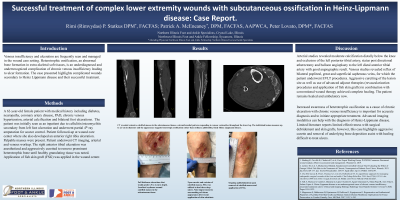Case Series/Study
(CS-131) Successful treatment of complex lower extremity wounds with subcutanceous ossification in Heinz-Lippmann disease: Case Report.

Venous insufficiency and ulceration are frequently seen and managed in the wound care setting. Heterotrophic ossification, an abnormal bone formation in extraskeletal soft tissues, is an under-diagnosed and under-recognized complication of chronic venous insufficiency leading to ulcer formation. The case presented highlights complicated wounds secondary to Heinz Lippmann disease and their successful treatment.
Methods:
A 62-year-old female patient with medical history including diabetes, neuropathy, coronary artery disease, PAD, chronic venous hypertension, arterial calcification and bilateral foot ulcerations. The patient was initially seen as an inpatient due to cellulitis/osteomyelitis secondary from left foot ulceration and underwent partial 4th ray amputation for source control. Patient followed-up at wound care center where she also developed 2 anterior right tibia ulcerations. Palpable masses were present. Patient underwent CT imaging, arterial and venous workup. The right ulcerations were anesthetized and aggressively curetted to remove prominent heterotrophic bone until healthy granulating tissue was noted.
Results:
CT revealed extensive calcified masses in the subcutaneous tissues a circumferential pattern responding to venous varicosities throughout the lower leg. The individual lesions measure up to 2.5 cm in diameter and the appearance suggests heterotopic ossification rather than ordinary phleboliths, likely Heinz Lippmann disease. Arterial studies revealed moderate calcification distally below the knee and occlusion of the left posterior tibial artery, status post directional atherectomy and balloon angioplasty to the left distal anterior tibial artery with good angiographic result. Venous studies revealed reflux of bilateral popliteal, great and superficial saphenous veins, for which the patient underwent EVLT procedures. Aggressive curetting of the lesion sites as well as advanced adjunct therapies (revascularization procedures and application of skin substitutes) in combination with conventional wound therapy achieved complete healing. The patient remains healed and ambulatory now.
Discussion:
Increased awareness of heterotrophic ossification as a cause of chronic ulceration with chronic venous insufficiency is important for accurate diagnosis and to initiate appropriate treatment. Advanced imaging modalities can help with the diagnosis of Heinz-Lippmann disease. The literature reports limited effectiveness with surgical debridement and skin grafts, however, this case highlights aggressive curette and removal of underlying bone deposition assist with healing difficult to treat ulcers.
Trademarked Items:
References:

.png)